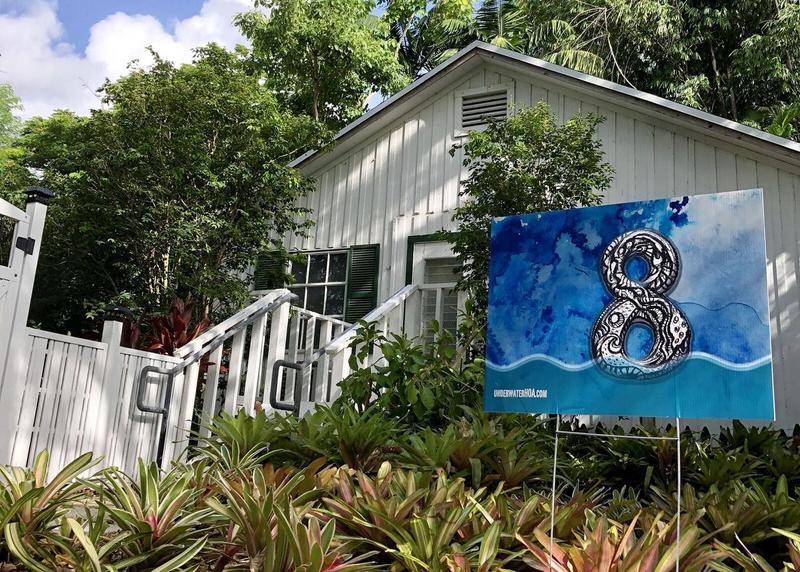
Xavier Cortada, “Underwater HOA: Marker 8,” 2018.
Mapping the topography of a conceptual coastline is the basis of Cortada’s Underwater HOA project, necessary “to make the invisible visible.” Working in conjunction with Cortada’s Antarctic Ice Paintings from 2006, Underwater HOA is a participatory art project that depicts South Florida’s vulnerability to sea-level rise, specifically this vulnerability towards homeowners within South Florida. The goal of this project is to inform citizens on the impending issue of sea-level rise while also facilitating discussions of change within the community by holding monthly “HOA” meetings. As part of the project, Cortada worked with the Village of Pinecrest to encourage its residents to install a “marker” in their front yard, this marker being a yard sign that depicts the house’s current elevation above sea level above a backdrop of Cortada’s Antarctic Ice Paintings that are literal depictions of melted ice. The introduction of such drastic imagery further emphasizes the urgency of the issues Cortada presents, issues that need to be addressed now.
These markers function as a catalyst for conversation, prompting passerby to question the sign’s purpose and ideally prompt further involvement. However, they are also literal markers, their installation effectively mapping Miami’s elevation above sea-level across various parts of the community. By mapping Miami’s elevation above sea level, the markers are able to achieve a subversive presence through their own existence, the concept of openly stating a house’s current elevation addresses the current precariousness of the real estate market in Miami. This presents these issues from a rather personal perspective, as Cortada prompts action by making the problem a selfish one; even if you can’t or won’t initiate change for others you probably will do it if it’s in your own self-interest. While this is an effective strategy for promoting involvement from its participants, it also allows for a sense of self-realization from its participants that permeate into collaborative efforts.
Cortada’s acknowledgment of universal self-interest is a necessary point of departure to the success of the project, personal autonomy being the primary motivation for engagement by most participants. However, the form in which this is achieved, a participatory art project, forces a relinquishment of this autonomy from its participants as well as the artist. As noted by Claire Bishop in her essay, the Social Turn, “participatory projects in the social field therefore seem to operate with a twofold gesture of opposition and amelioration. They work against dominant market imperatives by diffusing single authorship into collaborative activities” (Claire Bishop). Contextually applied to Underwater HOA, this appears to be a necessary aspect of the project, the ability, and need, to foster community through collaborative action being twofold in its effect; that of environmental mitigation, intended, as well as a conceptual and practical point of departure reliant on communal autonomy.
As the project has grown, Underwater HOA has shifted from establishing community groups under the guise of a “homeowner association” into an infiltration of already existing, functional, homeowner associations throughout South Florida. This approach lends itself to being viewed as a form of institutional critique, the institutions in question being that of governing residential/community organizations. Where this differs from traditional forms of institutional critique within art historical canon is in its complete dismissal of esoteric values typically associated with the medium, being that of a critique of systems in an art world context. In this way, the infiltration of already established HOA organizations offers both a critique of the systems in place as well as a solution to the problems being addressed. Rarely does this type of art allow for first-hand participants rather than a secondary audience, however Cortada accomplishes this by effectively transforming issues of global scope into a residential nodus that needs to be engaged by individuals.
To see the original webpages from the project’s launch in 2018, please visit the Underwater HOA archives.
